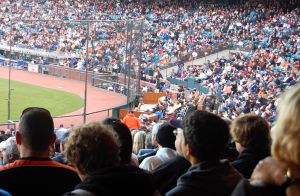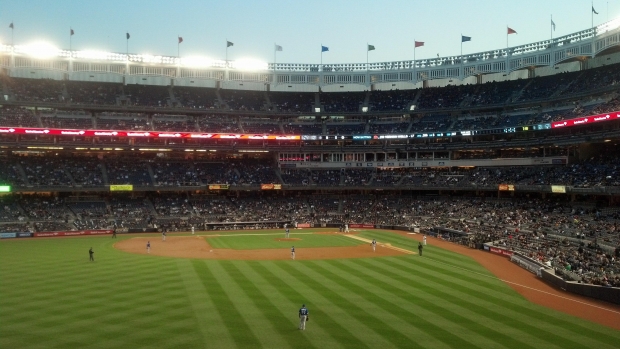It is the dream of millions of kids across the country to play professional baseball when they grow up. But can you imagine if you worked your entire life towards that dream, only to have it shattered in your very first professional game before you even got to step up once to the plate?
Such was the sad case of Dustin Fowler, a prospect who got his first shot in the MLB with none other than the Evil Empire themselves – the New York Yankees – in June of 2017. Chasing a foul ball and trying to make a play, Fowler ran at full speed into what appeared to be a padded section of wall during an away game in the ballpark of the Chicago White Sox.
However, the section of wall that Fowler unluckily found himself on a collision course for was actually an unpadded electrical box, indistinguishable from its padded wall surroundings. Fowler suffered an injury to his patellar tendon, requiring season-ending surgery and slamming the brakes on his dream that was finally becoming a reality.
Rather than wallow in despair and wonder what could have been, Fowler tackled his rehab after successful surgery and went one large step farther – he filed suit against MLB and the White Sox stadium ownership for failing to ensure a reasonably safe work environment, which ultimately caused his injury, pain and suffering and potential loss of significant income.
Taking the MLB to court
As Michael McCann points out in a recent Sports Illustrated article, professional athletes aren’t likely to pursue legal action against their employers due to a number of reasons. Perhaps they fear public backlash they might receive, perhaps they don’t want to deal with court proceedings and the disruption that could cause to their training regimens. Besides, professional athletes are paid among the highest of employees in the country and have collectively bargained for outstanding health care – so suing to receive financial compensation may not be a top priority either.
Most importantly, however, professional athletes don’t often sue following an injury because they assume the risk of injuries when they sign their contract to play professional sports. Had Fowler simply slipped while tracking the foul ball and broke his arm, he’d have no real legal recourse against Major League Baseball, as that situation is one that could be reasonably expected to happen throughout the course of any baseball game, to any player at any position.
What makes Fowler’s case unique – and why a federal judge just upheld the case’s right to proceed despite an attempt from the MLB and White Sox to have it thrown out – is because it challenges the notion of what a reasonable assumption of risk is for professional baseball players.
The defendants in the case have essentially argued that safety issues within major league ballparks are handled by a specialized safety committee that is charged with addressing potential hazards to players’ health, and that they are not liable for injuries that occur due to safety hazards that aren’t realized and addressed by the committee. However, the judge ruled in favor of Fowler – who argued that the language within the MLB’s collective bargaining agreement with the players’ union only states that the safety committee will address hazardous situations as they arise, and therefore are not expected to safeguard against every potential, unknown safety hazard at every ballpark.
If a player were to sue Wrigley Field because they slammed into their famous ivy-covered brick wall, they would be unlikely to succeed, as the brick walls at Wrigley are a well-established, well know feature of the ballpark that is essentially engrained into baseball’s storied history. Players could be expected to know the brick wall exists.
However, a random electrical box that has no protective padding and is placed along the same span of wall as other padded sections – and is painted the same color – is not something the average player would know about. This is partially why Fowler’s case has persisted. Continue reading
 Boston Injury Lawyer Blog
Boston Injury Lawyer Blog


 Fan safety has been a very important topic in professional sports, as fan injuries have become more and more prevalent at sports stadiums. Also this weekend, some rowdy fans from the University of Maryland were injured after a section of bleachers collapsed at Ludwig Field during a soccer match against Duke. Last month a 30-year old Atlanta Braves fan died during a baseball game at Turner Field when he fell nearly 70 feet from the upper viewing deck.
Fan safety has been a very important topic in professional sports, as fan injuries have become more and more prevalent at sports stadiums. Also this weekend, some rowdy fans from the University of Maryland were injured after a section of bleachers collapsed at Ludwig Field during a soccer match against Duke. Last month a 30-year old Atlanta Braves fan died during a baseball game at Turner Field when he fell nearly 70 feet from the upper viewing deck. When incidents like this occur, the first questions people usually ask are “Why did this happen?” and “Who is responsible?” People are also concerned about how the incident could have been prevented and how future similar incidents could be prevented. Referring back to an earlier blog we posted about fan injuries in stadiums, there are several things that can explain the legal responsibility a stadium owner has to a fan that has been injured while at the vicinity.
When incidents like this occur, the first questions people usually ask are “Why did this happen?” and “Who is responsible?” People are also concerned about how the incident could have been prevented and how future similar incidents could be prevented. Referring back to an earlier blog we posted about fan injuries in stadiums, there are several things that can explain the legal responsibility a stadium owner has to a fan that has been injured while at the vicinity.






